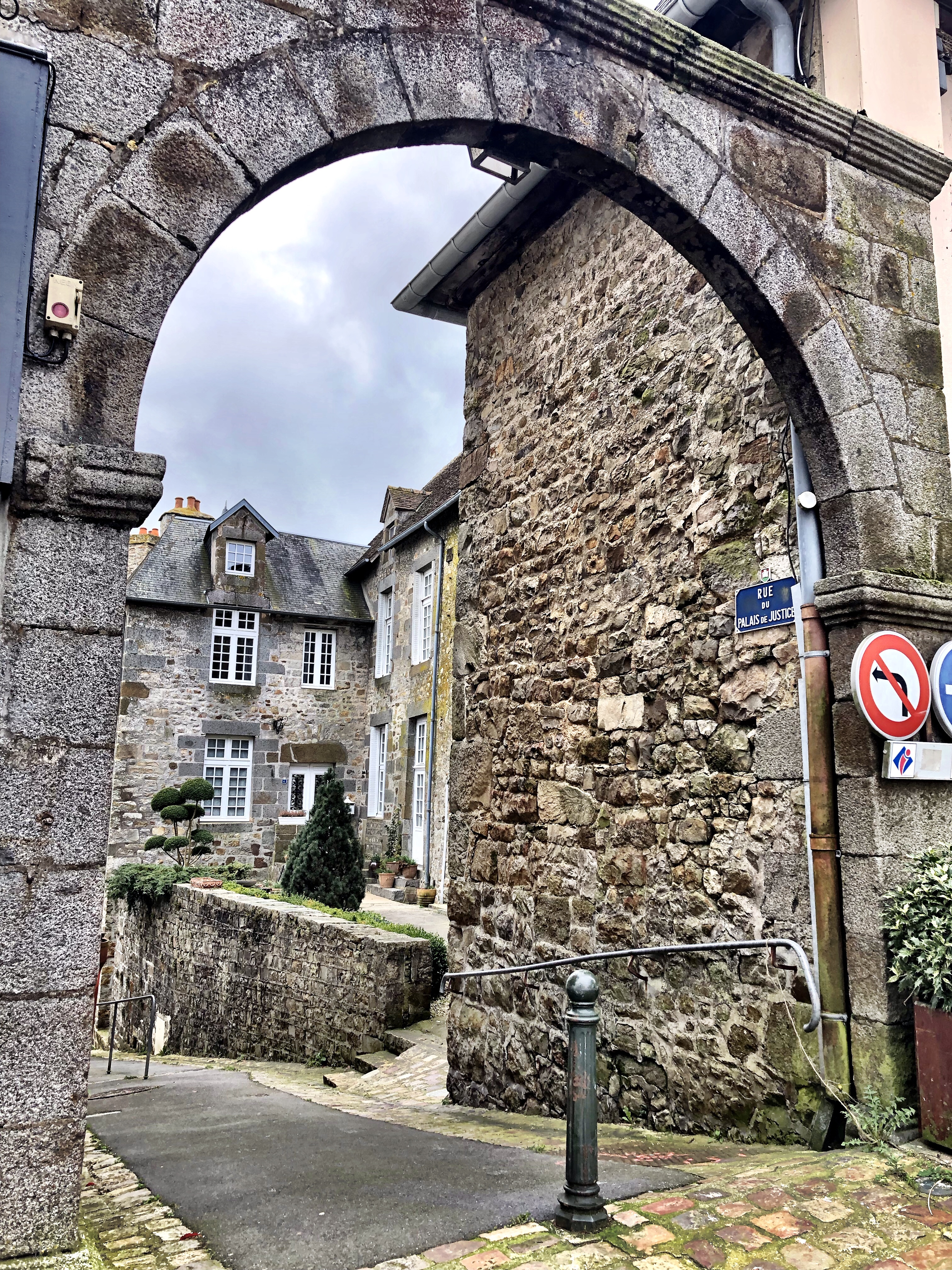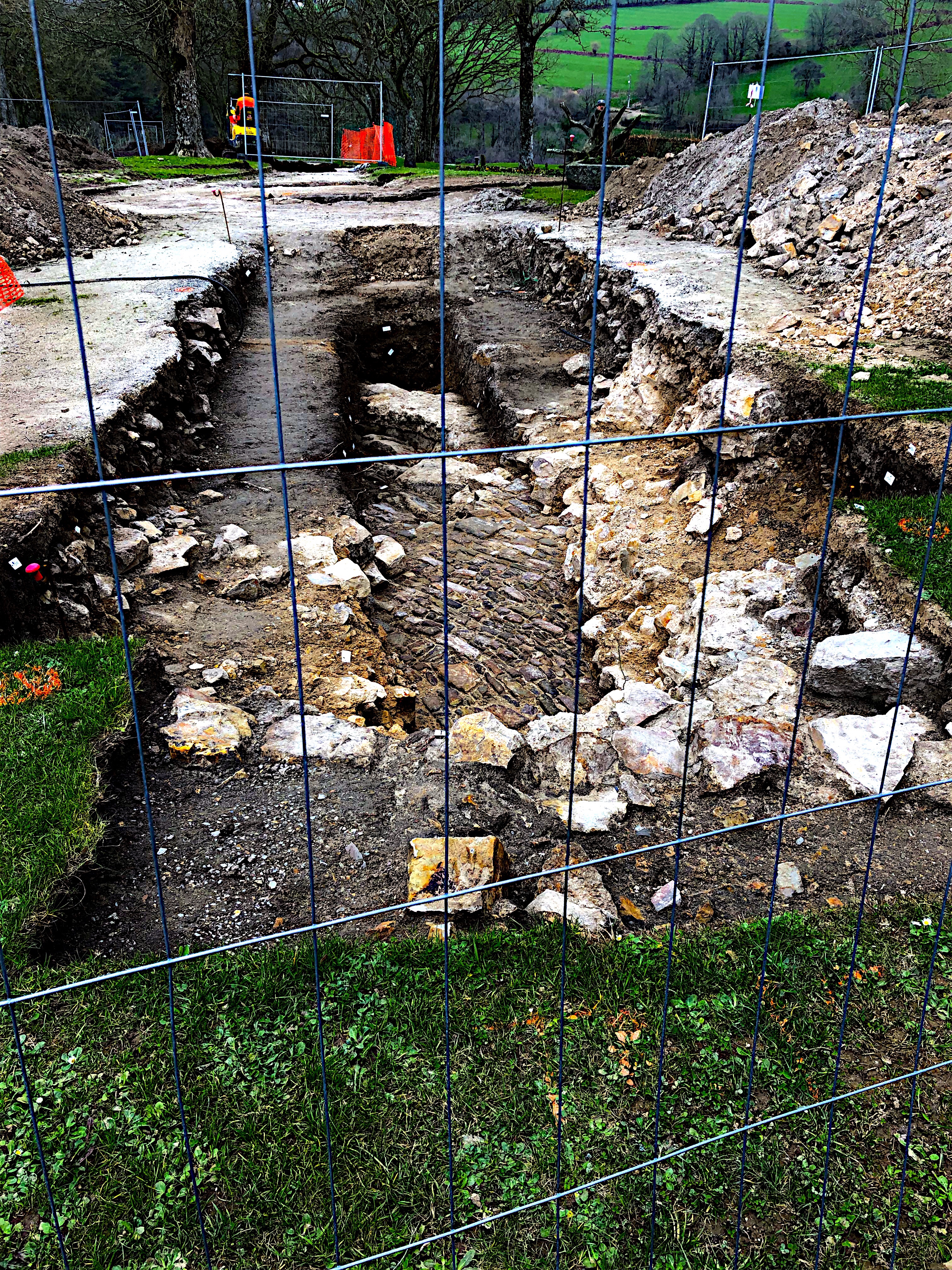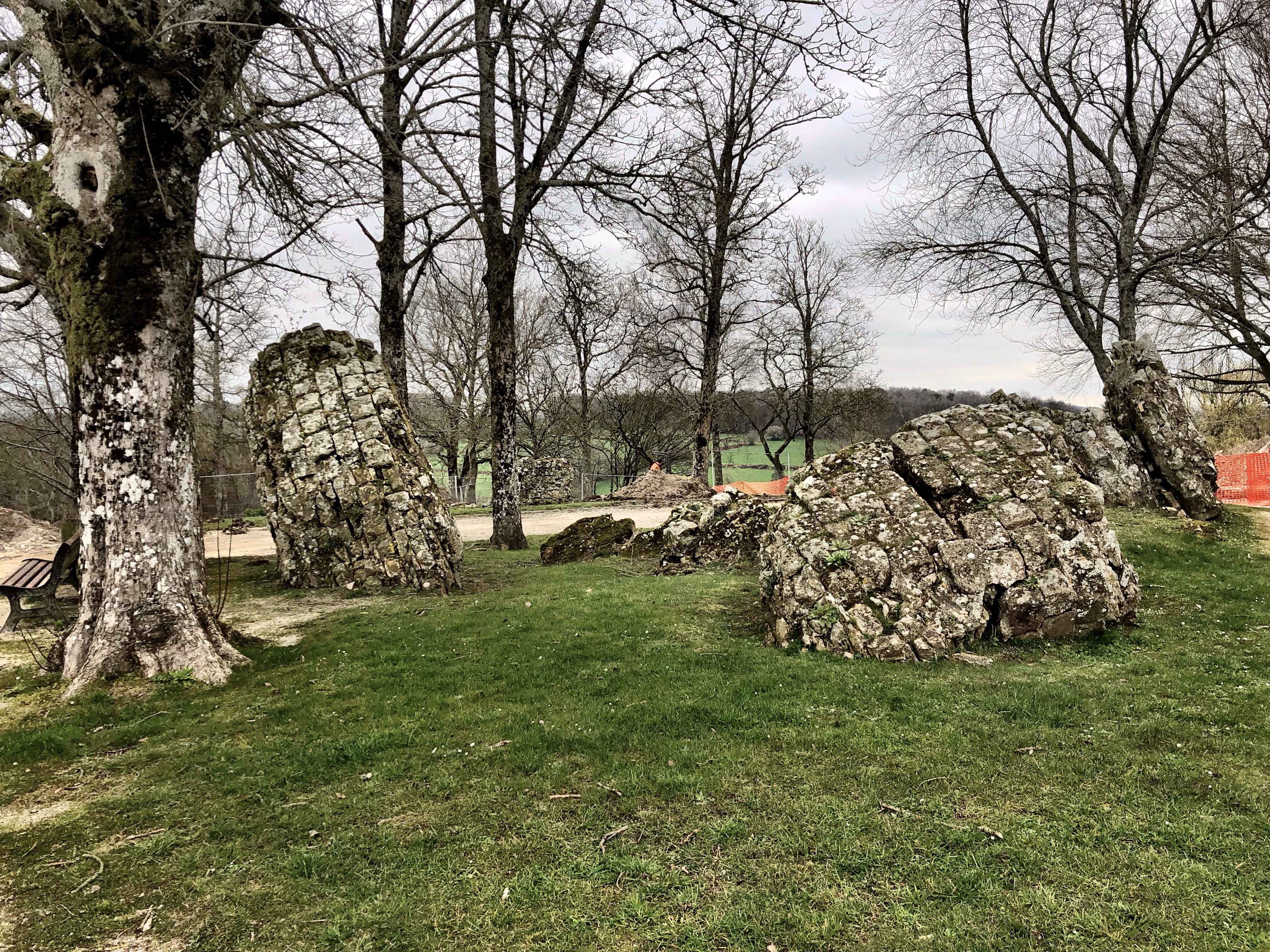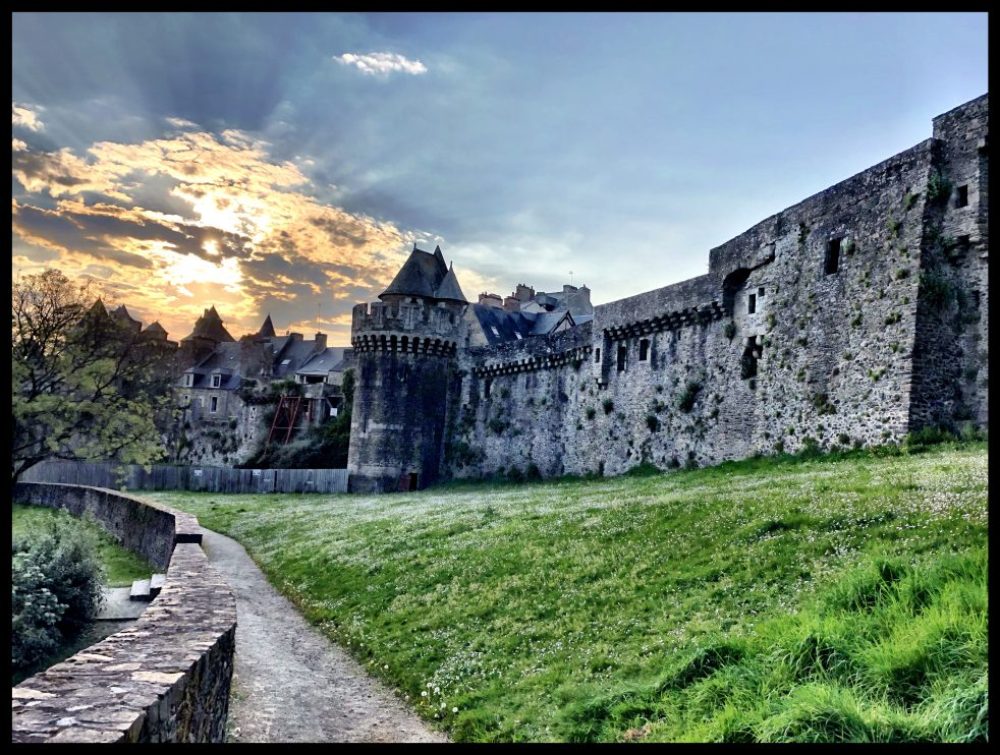
To the northeast of Fougères stands a series of grey, stony hills through which the Varenne river carves a winding course as it rushes southward, seeking release into the sea. The flatlands surrounding these hills are broad and sparsely populated, taken up with the business of farming and dotted with the occasional small village or hamlet. Fields play host to herds of dairy cows and sheep cropping the rich grasses and herbs which thrive in this showery part of the world. It’s lambing season. Dim, tangled silhouettes of apple orchards, now long-neglected, occasionally show themselves. The chill of winter still permeates the air and the ashen sky filters a grainy tone onto the landscape. Perched atop one of the rocky promontories, commanding the scene, is Domfront.
We had been wanting to visit Domfront for some time. A few photos of castle ruins was all I needed to entice me. And we needed a break from our daily occupation of house renovation. So, it was with relief and anticipation that we downed tools, cleaned ourselves up, donned clothing suitable for mixing with the non-renovating public and tootled off through the countryside toward Normandie.


Domfront, we discovered, has a rich history. As a settlement, it goes back to the 7th century. But it properly takes off in the beginning of 11th century when a sizable wooden fort was established on top of a rocky hill with a commanding view of the surrounding territory. Later in the 1090’s, Henri, the fourth son of England’s King William (the Conqueror), replaced this with a large stone castle. Domfront became Henri’s base in Normandie and, after a family feud of epic proportions, he became King of England and Duke of Normandy. The castle and town also played host to such royal notables as Kings Henry II (infamous for encouraging the murder of St. Thomas à Beckett) and Richard I (famously lion-hearted and absent crusader), John (notable for political ineptitude and one Magna of a Carta), and Eleanor of Aquitaine (successfully queen of France, then England, and all-around legendary influencer). It was also the center of Protestant (Huguenot) uprising in Normandie in the 16th cenury, ending in a royal siege of the town in 1574.

These days, Domfront is a small regional town, situated in the department of Orne some 70 kilometers due east of Mont Saint-Michel. The outskirts on the lower slopes of the hill are a bit run-down. Signs of a perhaps more prosperous past in tourism and industry are still evident – shuttered hotels and restaurants, and unwashed billboards now covered with a green, grainy film of algae and lichen. But the area seems to be struggling now. Then again, it was a cold, damp day in the middle of the week during the in-between months of late winter in the midst of what are, hopefully, the waning days of a global pandemic. Not really a fair time to judge any town’s prosperity.

After an approach which winds up the steep hillside, we found a nicely cobbled car park where we lodged the trusty Audi. Literally steps away from the car, standing proudly sentinel over the shops at its feet, is a stone tower, all that remains of the medieval gate: Porte d’Alençon. But it doesn’t stand alone. Obscured amongst the many quaint stone building along its length are the remains of the medieval wall which once protected the town from invaders or rival nobles. Despite this, the English managed to capture Domfront twice during the Hundred Years War – once occupying it for 32 years in the 15th century. The French only retook it in 1450 after a 20-year siege!






Following the Grande Rue from the gate up the hill takes you past a tantalizing wealth of medieval houses and shops. And this continues at the summit where the narrow streets multiply into warrens of of small courtyards ringed by ancient townhouses of timber and stone. There are numerous examples in Domfront of domestic architecture from the Middle Ages and Renaissance eras. History geeks like us will be happy to see such an extensive area of streetscapes that harken back to earlier eras.


For some of you, all of that dusty history can make your throat dry. Fear not! For Cherie and I found a nice little bistro in the center of the old town called the St. Julien. This might come as a surprise to you, but they sold things to drink! Cherie is not really one for beverages. Except for black tea with milk and sugar. That’s her go-to drink. This really didn’t look like a tea kind of place, so she opted for water. For my part, I noted that they offered a locally brewed beer: an Ambrée Domfrontaise. How could I refuse? And what a good choice it was. An excellent beer. I thoroughly enjoyed it. Just for appearances, we ordered lunch as well. The bistro was filled with locals and one other table of visitors. It was nice to sit amongst regulars, all of us enjoying a satisfying and relaxed lunch – French style. A small pleasure but one we never fail to appreciate as part of our lives in France.

After lunch I couldn’t wait any longer. We made a bee-line to the castle ruins where Cherie, with her usual patience and good humor, indulged my long progress through the site of yet another once-great French castle. Château-fort Domfront was a formidable castle, standing as it did for centuries at the terminus of a steep-sided ridge line of solid rock. It lasted until the beginning of the 17th century when King Henry IV of France had it razed, apparently in order to prevent any more Huguenot upstarts from using it as a bastion of faith. [I should note here that a branch of my mother’s family, the Lefevres – but one of many alternate spellings – were Huguenots (Protestants) and had to flee France in the 17th century, leading them to take up a new life in that far-flung wild place called America. I wonder if they themselves had any connection with Domfront?] As a result, there are now only ruins to admire. But there is still much to see, particularly the standing remains of the central donjon, part of the original 11th century keep. It’s still an imposing sight and one can easily imagine the majesty and power such a tall structure must have projected throughout the entire demesne which it overlooked.



The area of the castle grounds is littered with massive chunks of masonry walls, laying about at odd angles as though giants had tossed them like dice. The clear outlines of the outer curtain wall are still quite evident, the bases of the encircling defenses remaining intact. We were fascinated to see that a comprehensive archeological investigation was underway throughout the site. There were several trenches in progress and were were able to get quite close to them. Cherie and I are both interested in archeology (Time Team fanatics to our cores!) so we were happy to watch the work being carried out for a time. The site also affords broad panoramas over the Varenne and the lands below. For these many reasons, the ruins of Domfront are well worth a visit.

We ambled back through more impossibly old, narrow streets, stopped at a nice little boulangerie to pick up a local apple pastry for later, and descended the hill toward the car park via a picturesque alley lined with cute pocket gardens. Sadly, our dog Saxon can’t walk as far or as for long as he used to, so we generally leave him home now. He had a pretty bad few months last year when his cervical disc problems, his resulting neuritis in his front limbs, and his rear hips and knees were quite painful and limiting. But with a lot of specialized therapies and careful management of his activity, he has improved to the point where he is functioning well and with much less pain. As long as we don’t push him (or allow him to push himself) too far. Nevertheless, we were anxious to return home to him.

We were happy to get out to visit yet another fascinating town with a rich and interesting history. There is much to see and appreciate in Domfront and we enjoyed sharing it together. What’s next on the itinerary? We have no idea. Mostly, we wing it. But wherever it is, we’ll be sure to report it here. France is magnificent. There is so much to do and see here. Not to mention the simple yet satisfying act of just … being here. We wish you could all experience it too. And, why not?


Hi Guys Carol and I are in Palm Beach Florida. Just closed on our beach condo. I also have a new phone after my old one quit working and zeroed out all previous information. It missed this one for some reason so I hope this reaches you Love Pop
On Wed, Mar 16, 2022 at 7:44 AM Finding Our France wrote:
> John Kocan posted: ” Ruins of Past Glory – the Castle of Domfront To the > northeast of Fougères stands a series of grey, stony hills through which > the Varenne river carves a winding course as it rushes southward, seeking > release into the sea. The flatlands surrounding” >
LikeLike
Stumbled across your blog sometime ago and I do enjoy your posts, you have inspired us to visit the chateau (that really is a castle!) in Fougeres and also the one in Mayenne, life is very hectic just now but I am compiling a list of all these wonderful places on our doorstep for less busy times and your blog posts are turning into our local guide, so thanks and do keep reporting back on the places you visit!
LikeLike
Thank you for this very interesting read, we live quite near Domfront and I have often wondered about its history and haven’t yet had time to find out more. We’ve visited the Castle on a very cold and wet day, but even then it was super impressive as were the views of the surrounding country side. We must go back and have another look now we have a better insight to its past. Thanks again
LikeLike
Thanks for for your kind comment. I’m glad my post piqued your interest in Domfront and it’s history. Given that you live in the area, you are fortunate to be in a lovely area indeed. We are hoping to visit much more of Normandie. There is so much to see!
LikeLiked by 1 person
Hey John
LikeLike
Well … hey! Thanks for taking a look at our blog, Wade.
LikeLike
But of course (add as many wee, wee and poo, poos as you like)
LikeLike